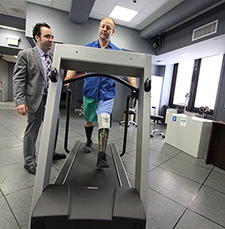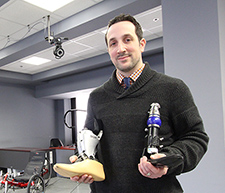Office of Research & Development |
 |

VA Research Currents archive
March 23, 2016

Ed Sliwinski, a prosthesis user and prosthetics technician, walks on a treadmill under the watchful eye of Dr. Leif Nelson, assistant chief for clinical care in the Extremity Trauma and Amputation Center of Excellence. (Photo by Mitch Mirkin)
Dr. Jason Maikos' lab looks down on busy E. 23rd St. in New York City, a block from the East River. Across the street is a sprawling complex of tall red-brick apartment buildings named after Peter Stuyvesant, who oversaw the Dutch settlement on Manhattan starting in 1645. A year earlier, Stuyvesant had lost his right leg to a cannonball in a battle to take a Spanish-held Caribbean island. His leg was replaced by a wooden peg, which he adorned with silver nails.
Prosthetics has come a long way—witness the $35,000 computerized knee that sits on a table in Maikos' Gait and Motion Analysis Lab, coupled with a $30,000 bionic foot.
The high-tech components are awaiting testing with Veteran amputees who come to the lab. Some have lost a leg to an IED or rocket-propelled grenade in Iraq or Afghanistan—or perhaps to a mine or mortar blast decades ago in Vietnam. Others have lost a foot or leg in an accident, or to diabetes or vascular disease.
The purpose of the tests is twofold: to help determine the best prescription for the Veterans, and to gather research data. Along with gait abnormalities, Maikos studies functional outcomes such as walking speed and distance.

Dr. Jason Maikos, a biomedical engineer, directs the Gait and Motion Analysis Lab at the VA New York Harbor Healthcare System. (Photo by Mitch Mirkin)
Maikos, a biomedical engineer, wants to help shift prosthetics prescribing to a more objective, scientific process. Right now, the process relies heavily on anecdotal knowledge and the clinical instincts and judgement of prosthetists, physiatrists, and physical therapists. Their assessment can sometimes be based mainly on watching how the patient walks.
"In a visual gait analysis, any two clinicians will agree on approximately 60 percent of the anomalies they see," says Maikos. "In our lab, the 40 percent variation is taken out of the equation. We work with objective measurements."
His lab was set up in 2010 to offer state-of-the-art clinical evaluations for patients across the VA region—facilities spanning the five boroughs of New York, Long Island, the Hudson Valley, and northern New Jersey. Since that time, Maikos has also worked to build a diverse research portfolio, with funding from VA, foundations, industry, and other sources.
"We don't care if you're younger or older. If this knee is going to benefit you, our team can prescribe it."
The equipment in the lab allows him to discern movement abnormalities on a much smaller scale than is possible with naked-eye observations. But mainly, says Maikos, "it's more objective than a subjective visual analysis."
There are several such gait labs throughout the VA system. Unlike biomedical labs, typically crammed into narrow rooms where every inch of counter and shelf space is taken up with glassware, centrifuges, hot plates, and other equipment, a gait lab is more open and spacious. There has to be room for patients to walk—that's the whole idea.
Whether the issue is limb loss, partial paralysis, or any other mobility impairment, the patient or research participant will walk across the floor, up and down a movable three-step wooden staircase, and up and down a large ramp, set at varying slopes.
Maikos' lab also has a treadmill, a bicycle mounted on a trainer stand, and a recumbent tricycle. And in one corner is a rectangular patch of green turf—a mini golf course, part of a larger adaptive golf program, where the team can study the biomechanics of a Veteran's swing.
In the center of the lab, four rectangular force plates are embedded in the floor, sitting on a concrete bed. Two of them have glass tops, so a camera mounted underneath can record a patient's step from below. The plates measure the ground reaction forces as the foot hits the plate. There's also a pressure-sensitive walkway that lets the researchers gauge pressure on different areas of the foot.
Look overhead in the lab and you'll see eight high-speed video cameras mounted on the ceiling around the large room, all pointed toward the center. Each camera has a ring of infrared LED lights. This is part of the motion-capture system—the centerpiece of any gait lab. Maikos explains how it works:
"We apply markers to the patient. These are spheres covered in reflective tape—the same tape you might have on your sneakers. We place the markers on strategic locations on the body—joint centers, bony landmarks. When the cameras are on, a strobe of infrared light hits the markers and gets reflected back into the camera's detector. If any two cameras capture any one marker on the body, you can recreate its location in 3-D space. So we can start to look at joint motion and joint angles."
A patient or research participant, taped up with markers, walks back and forth across the floor, or on a treadmill. Maikos sits nearby behind two ultra-wide curved monitors and uses motion-capture software to analyze the person's gait and build models of it. The patient appears as an animated 3-D figure on the screen, the movement of his joints and limbs translated into precise numerical values.
In Maikos' prosthetics studies, the technology allows a granular look at how a Veteran is adapting to a prosthetic foot or leg, and how the components are affecting his overall biomechanics.
In one pilot study, funded by the American Orthotics and Prosthetics Association, Maikos has been evaluating Veterans fitted with a microprocessor-controlled knee and a powered ankle-foot device. The ankle-foot, called the BiOM, was developed in part with VA funding, by a team led by Dr. Hugh Herr of the Massachusetts Institute of Technology.
"The big thing with the BiOM is the power," says Maikos. "It provides that biologically normative ankle power."
The above-the-knee amputees taking part in the study also get to try out an advanced leg called the X3, which its manufacturer, Ottobock, calls "the world's most technologically advanced prosthetic leg."
Maikos explains what makes the leg special:
"In addition to the microprocessor, it has gyroscopes and accelerometers, so it knows which direction you're walking in, which is important. On the older C-Legs [an earlier, slightly less sophisticated computerized model], if you took a step backwards and landed on the toe with the knee extended, it would buckle and you could fall. So a product like the X3 allows you to walk backwards, or in any direction you want, and the knee knows which way you're going."
Maikos adds: "You can use the Walk2Run mode when there is a need to run, and it intuitively provides a large swing angle for running. It also has built-in stance phase flexion, which acts as a shock absorber so the force of your heel hitting the ground gets attenuated a bit as it translates through the other joints. That's an important biomechanical feature."
The X3 made of titanium, aluminum, and stainless steel, is also rugged and waterproof. "It's completely submersible in water," says Maikos, "which is a popular feature among our Veterans for water activities, and even showering."
The model is also "nearly impenetrable by dust or dirt," says the company, which designed it with active-duty service members in mind.
In the VA system, you might think only Veterans who are prime athletes would get such a leg, which costs around the same as a 2016 Chevy Camaro—in the neighborhood of $30,000 to $35,000. Not so.
"If there's a medical justification, a Veteran will get it," says Maikos. "There's a push to continue an active, healthy lifestyle. We don't care if you're younger or older. If this knee is going to benefit you, our team can prescribe it."
Of course, not every Veteran needs or wants the latest and greatest componentry.
"Some people prefer a simpler 'set it and forget it' system," says Maikos.
He says there are more than 100 models of prosthetic feet on the market, from the $30,000 BiOM, to standard carbon-fiber "energy storing and returning" models that cost around $1,100.
Those simpler feet are based on a design pioneered by VA researcher Dr. Ernest Burgess in Seattle in the 1980s, in collaboration with Boeing Aerospace. It makes use of lightweight, springy materials.
"The foot stores energy during heel strike," explains Maikos. "As you roll forward through stance phase, it returns some of that energy at push-off."
One goal of Maikos' research is to learn more about who does better with which types of components. "The studies we're doing now are helping to determine some preliminary prescription criteria," he says. "We want to develop guidelines."
In future research, he wants to look not only at users' physical characteristics, but also at the cognitive abilities necessary to learn various features and use them effectively. This is less of an issue with lower-limb prosthetics than with artificial hands and arms—which have far more functions and degrees of freedom—but it's still a factor, especially with products like the X3.
"We want to know which candidates are best to get these devices," says Maikos. "We now have some data to seed future studies to explore these topics more in depth. Who will benefit most from a certain type of device, and who's going to want to use it?"
Another question he hopes to study: Can lower-limb amputees benefit from a regimen of physical therapy that is specifically designed for their particular device?
On the whole, Maikos believes "the field of prosthetics can greatly benefit from this type of research. We can maximize the use of these advanced technologies."
Peter Stuyvesant, immortalized in a statue—peg leg and all—in a nearby park that bears his name, would no doubt have been interested.